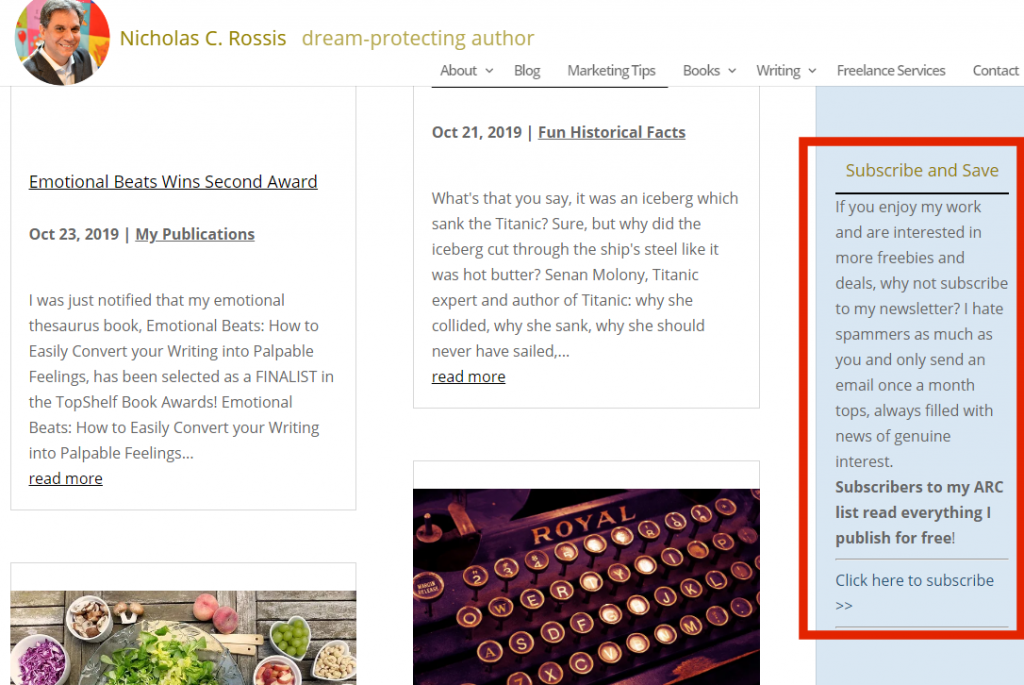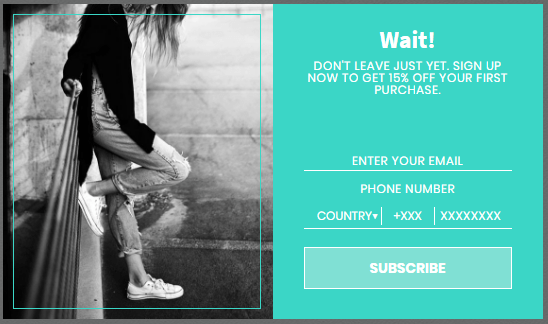In my last post, I discussed the top 7 email marketing strategies for self-published authors. The very first tip was, “the list is Number 1.”
But how do you create a mailing list? That’s a challenge many authors struggle with.
Thankfully, I came across a great post by Karolina Petraškienė on Omnisend with some helpful tips on building your email list.
General Email List-Building Tips
Before I share the rest of Omnisend’s tips, let’s start with two important dos and don’ts:
1. Keep your list healthy
Keeping your list healthy means that you approach those people who are aware of you, engaged with your author brand, and have signed up for your newsletter.
Not only does this make it easier to engage them, but a whopping 30% of subscribers change email addresses every year. So, no matter how long and hard you have been collecting your emails, you should delete inactive email addresses on a regular basis (e.g. once per year).
Focus on the quality, not quantity.
2. NEVER buy an email list
This one is such an important point to make, and one that many new marketers are falling for.
There are many shady people on the internet who will sell you email lists with hundreds of thousands of “quality” (read: not quality) contacts that are supposedly perfect for your business.
But you know they’re not. You’re just hoping that at least some of them are (maybe 2% wouldn’t be bad, right?).
But that’s bad thinking. Here’s why:
- If you’re buying an email list, there’s a huge chance that other people are buying the same email list.
- That email list may be a pure spam trap, or have spam traps, meaning if you send emails to those contacts, your sender’s email address and IP address will be blacklisted as spam.
- Even if those people aren’t spam traps, they may still be poor quality leads. So, several of them will mark you as a spammer. Think about it: 10,000 contacts marking you as spam. Your sender’s reputation is as good as dead.
- With enough spam complaints, your email service provider may terminate your account.
- You are violating the GDPR, as those contacts (who reside in the EU) did not opt in to your list. You can face heavy penalties.
- You will spend a decent amount of money on acquiring that list, and for sending your campaign to the contacts on that list. Instead of sales, you may get all the consequences mentioned above. All that time would be better spent on generating a legit mail list.
So, if you want to kill your brand before you’ve even started, go ahead and buy an email list. However, if you want to be a smart author, follow the following proven tactics on how to build your (clean) email list from scratch:
#1 Underestimated standard opt-in form
One of the first, and default ways, for you to build an email list is by having a standard opt-in form on your site. Mine is on the sidebar:
#2 A surprise popup
While the opt-in form is important, it is nonetheless still quite passive. You are hoping that your visitors will sign up for your newsletters by their own will.
Furthermore, you can’t really gauge whether they’re already interested in your brand. A more proactive way is to use a popup form.
Popup forms are dynamic in nature. You can set them to pop up at certain times or for certain events and they are a great way to deliver lead magnets for lead generation.
However, I personally avoid them, as I find them intrusive and annoying. Still, they do work and you may wish to try them out to speed up the process of creating a mail list.
#3 Gamification
In order to build an email list, you need to attract and engage your visitors. Sometimes, however, discounts and sales are not enough.
In those cases, it’s a great idea to think outside of the box. There are now many interactive signup forms that are fun for visitors.
One of these is the Wheel of Fortune, a fun wheel that the visitor “spins” to get a prize. In order to spin the wheel, the visitor first has to sign up.
You can determine the prize as you wish, either as a book download or some other swag. Either way, it’s a win-win. The visitor gets a free prize, and you get to build your email list.
#4 A targeted landing page
You can also build an email list outside of your home page. Indeed, most marketers recommend having a different landing page for this, as you can then promote it separately from the rest of your content.
This landing page will have far fewer elements than the rest of your pages, as it is intended for high conversions by focusing on one offer only. In order for your visitors to win that prize, they’ll need to sign up.
With adequate testing, you’ll be able to improve your landing page’s conversion rates, build your email list, and boost your sales.
#5 Powerful lead magnets
People are generally skeptical of trying out new authors and normally quite reluctant to purchase anything the first time. If you want visitors to sign up, you need to give them something in exchange. Something that they would find relevant. But don’t offer “free updates”. No one really cares about free updates, it might even seem spammy.
Personally, I use a reader magnet: if you subscribe to my newsletter, you receive my entire Pearseus prequel for free. That way, you can see if you enjoy my writing and, hopefully, even buy more of the books in the series.
This helps convert my visitors into subscribers—at no cost to them.
You can give away any valuable resource—like a PDF guide, ebook, gift guide, stock images, etc.—that your visitors really want.
In order to get that resource, they will need to sign up for your newsletter and email campaigns.
Here’s a popup from AdEspresso offering a lead magnet in exchange for the visitor’s email address:
One note: the lead magnet should be directly related to your niche. If you write dark fantasy, the reader magnet shouldn’t be a collection of 500+ cute cats.
#6 Referral programs
Related to growing your email list by using giveaways, we want to use what we have (current subscribers) to get more of what we want to have (more subscribers).
An amazing way to do that is to use referral programs. It’s a tactic that helped Uber, PayPal, Dropbox, and Hotmail to become industry leaders in their fields.
With referral programs, you’re basically bribing (in a loose definition of the word) your subscribers to share your offers with their friends, family, and colleagues.
There are free ways to get referrals, where you don’t have to bribe your contacts with anything. These include:
- adding the option to forward or share your newsletters or welcome email with others
- adding the same option add the end of your reader magnets
They’re fine, but they may not be enticing enough.
So, in addition to that, you may give away something valuable in exchange for a referral. This can be a $5 coupon (if you sell your own books), a 25% discount, or even a free book.
This works wonders and helps you get new contacts, and even new readers, which—as I’ve mentioned—is the point of all of this.
#7 Offline list building
As you can see, the continuous list building process should be organized online – on your website, landing pages, social media, etc. However, always take advantage of and use “old-school” offline ways to collect emails when you can.
For example:
- Print your author cards and exchange with people when you meet them and talk about your books. Add received contacts into your list.
- If you participate in book fairs, have a registration list with an email column at your booth.
- Ask readers for their emails if you sell your products somewhere offline.
- Consider organizing meetups and gather like-minded people for discussions. Use a registration form for this.
For more tips, check out the original post on Omnisend. Also, check out a great post on e-commerce list building called, E-commerce List Building: The Definitive Guide and learn how to verify your email address. Next time: how to create a persuasive email opt-in form.








Trackbacks/Pingbacks